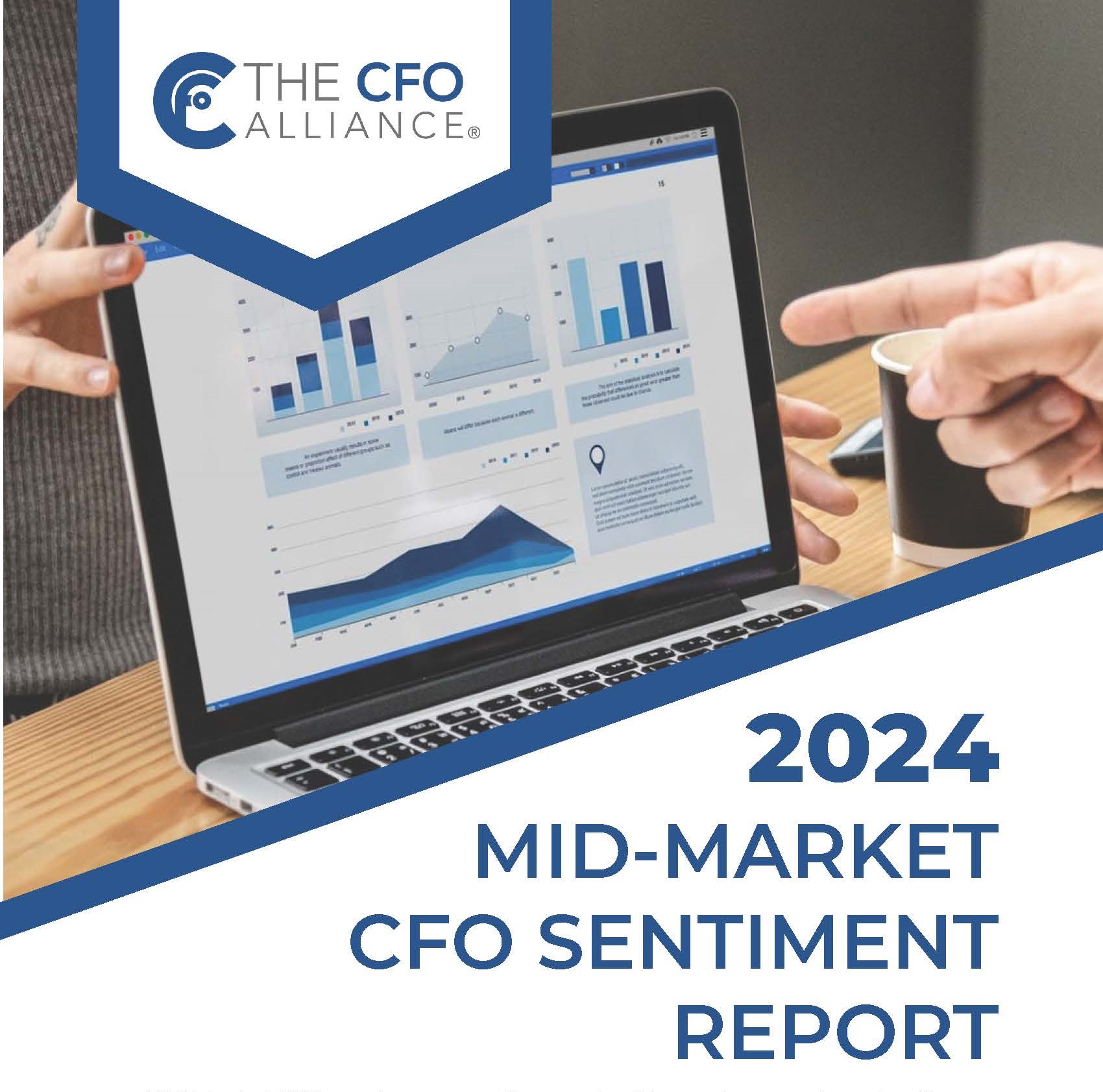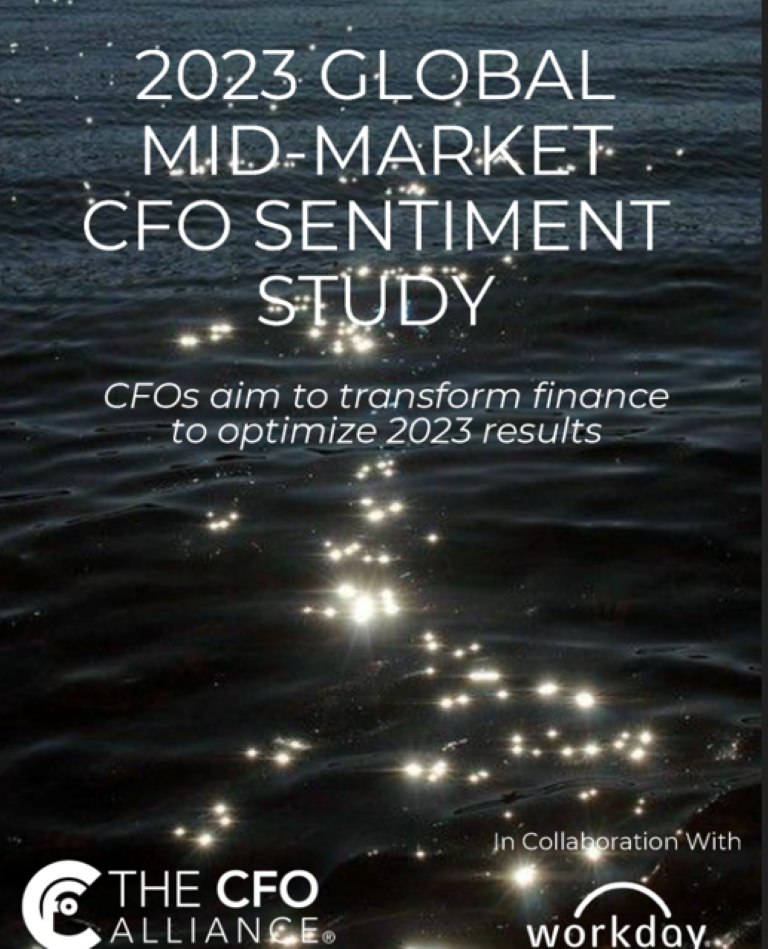A CFO’s Quick-start Guide to Diagnosing Top Line Shortfalls – PART 1
Top line growth has been the elephant in the room throughout 2023. Four quarters of dialog with hundreds of CFOs and finance executives at The CFO Alliance Roundtables has underscored waning confidence in meeting revenue goals. The Mid-2023 CFO Checkpoint Report (download here) signaled that for many enterprises missing revenue targets was apparent from very early into the year. Now, on the eve of 2024, is there a reason to believe the elephant will be gone and growth will happen? Let’s consider some causes and the prospects for growth going forward.
Economic Forces
Did inflation negatively impact revenue generation? Yes, higher prices have been a factor in stifling demand. How about inflation’s knock-on effect – that of consumers and businesses constraining spending? Yes, again.
And throughout the year, a stream of news and mixed views on the economy, some obviously sugar-coated to advance agendas, hasn’t provided confident direction on the actions to take. And even when projections were surrounded with “hard’ facts, they were contradicted by others just as convincingly.
The rate of inflation may be slowing but real purchasing power is a mere shadow of its former self. The history of this slippery slope began in 2008 and has accelerated in the last 3 years.
A soft and/or temporary recession arriving by the first half may be in store. Maybe not. So, Finance has been tightening spending throughout the year and accelerating cash accumulation to improve balance sheets and position for M&A. The stress will create bargain buys, and those maneuvering on the sell side will look better.
Looking forward, even the projections from the best forecasters don’t feel bankable. So, many enterprises are simply taking a more deliberate, spend-as-we-go approach on the growth investments intended to stimulate market demand. They plan to ride out uncertainty until they feel much more certain.
Look Deeper Inside the House
A recent Gartner survey of CMOs implies that even if the economy was booming, revenue growth could be a challenge unless the plan is a lay-up. And even if an economic boom enabled all boats to ride the wave up, survey clues imply that many enterprises won’t be able to fully exploit boomer conditions. Why?
The survey reveals core issues impacting growth beyond the business conditions colored by head-wind economic forces. More systemic internal issues have surfaced with half-lives that will take new smarts and time to re-work. And more importantly, the findings don’t point to big enterprises; the issues are pervasive across marketing and sales functions of small and mid-market businesses, too.
Anatomy of Marketing and Sales Shortcomings (or, Continuous Improvement Opportunities)
In the Gartner survey, marketers responded to this question, What are the biggest challenges your organization faces with its go-to-market strategy? Their answers were telling.
Competition received the highest number of mentions (51%). But unless you’re an iconic super brand, or selling a barrier-breaking product, or launching a new category definer, isn’t competition always assumed? Competition is a non-answer answer that is more indicative of an outcome rather than a barrier.
You have competition if you don’t have deep market understanding, compelling differentiation built into the value narratives of market-aligned products, a communication strategy to make a target market aware of and believe in the product, and a seamless buyer journey enabling target buyers to buy whenever and however they want to buy.
There’s a world of need for good strategic work implied here. Focus on getting these things right first and you will eliminate competition sooner in sales cycles. Your sales force will outperform others. If not, sales reps will be little more than expensive human websites.
Determining Product-market Fit and Strategy Complexity were tied as the second highest go-to-market challenge (43%). These are interrelated, but let’s first look at them separately.
Product-market Fit
- We live in a post-demographic era. Issues with product market-fit often indicate that what is known about target buyers is more anecdotal than intimate, precise, and predictive. The old definitions of target buyers marked by characteristics like age group, household income, business size, industry, etc. will only provide understanding of buyers at a veneer level. The countermeasure is to more deeply define the problem your product solves and the implications of the problem for those who use them, who benefits most from your product, what it does better, and what better is worth to the who that you defined. Also, get data, and ensure it’s a living, fluid organism capable of generating predictive behavioral indicators further out.
- Remember that data can point, but it can’t touch. So, don’t forget the emotional characteristics in building the profile because not all purchases are totally logical. Neuroscience has validated that a vital part of the purchase process is through the emotional limbic system in the brain. Factors like company/brand social approval, image appeal, personality appeal, trust, and salience are a few of the emotional considerations that if relevantly conveyed can create buyer attachment beyond liking and preference.
- The product could under-perform, or its benefits are misaligned with the most eligible customer-market sector. This allows the mention of competition as a challenge to be more valid, but it’s pointing to chink in product strategy and/or go-to-market strategy as the causes behind competition as a challenge.
Strategy Complexity
- Strategy is the point of the growth spear. But it’s one of the most mis-used and most mis-understood terms in the go-to-market lexicon. If a strategy isn’t developed according to its real definition, it will be complex!
- Begin with one basic diagnostic question: Is your strategy a strategy, or is it more of a plan for a plan containing a mix of goals, objectives, and a dizzying list of tactics?
- Strategy answers these questions and backs the answers with fact-based rationale:
- Where will you win (i.e., who, exactly, receives higher than average value from your product’s advantages)?
- Why will buyers choose you? (differentiates by client problems, needs and opportunities that your product solves best)
- How will you win? (Defines the buying journey and how you will make the buying experience remarkable. Defines the specific marketing and sales tactics to be implemented and why they were chosen over other options. Defines how the manner of executing the tactics will attract and transfer confidence to the market quickly)
- What is the value of winning? (Metricizes what success looks like, and lays out the “end-point vision”)
- The answers to these simple but aren’t-easy-to-answer-well questions will form the basic framework of a strategy. The enterprises that can answer these questions factually and granularly using a buyer-in lens versus one that’s product-out has a chance at defining a strategy that’s market-relevant and actionable.
- The content and execution of your strategy should attract and excite the market about the state of the possible with your brand/company, products, and experiences.
Building the Ideal Customer Profile was the next biggest challenge mentioned (40%). This is a major issue, and it simply tracks back to the perspectives thus far. If you don’t deeply know the target buyer’s needs, motivation, and behaviors, don’t invest in any major demand generation initiatives until you nail this down. It should go beyond demographic profiling, too.
- Consumer marketing should comprehend the personas of buyers at a psychological level. It should comprehend both logical (i.e., needs satisfaction) and emotional fulfillment factors.
- For B2B marketing, aspects of target market business models, strategies, and their customers are important factors in creating ideal profiles. Focusing on the buyers of your buyers will provide important insights that could help to create the how and why story explaining your product’s “fit”. And what can also be helpful is developing a profile that factors in the cost of non-conformance, i.e., who and what is at risk by not using your product and why?
Conveying Value Proposition was the next biggest mention (31%). Again, the inter-related nature of the challenges becomes evident. If the buyer is known only anecdotally or demographically, if the strategy does not define why buyers will choose your product, if the product is weak or its benefits are misaligned with buyer needs, and if the marketing communications strategy isn’t breaking through the clutter of competitive noise, you will not be able to craft a compelling and uniquely differentiated value narrative.
Go back to the beginning. Who is the buyer and what problems do you solve best for them? Until these strategy factors are developed and proven, the sales engine depending on them will not achieve its full potential for productiveness.
Measuring Success and Internal Stakeholder Misalignment rounded out the challenges, receiving 28% and 23% of mentions, respectively. These are both crucial components of a marketing and sales ecosystem, but they are less fundamental to the subject of generating demand than the others.
Certainly, if there is misalignment, understanding where and why it exists is key, and fixing the higher-ranking fundamental challenges will likely improve internal alignment significantly.
And as far as measuring success is concerned, numbers will tell the story best. ROI measurement models will vary by tactic, and they helpfully answer the question, What is the value of winning?
CFOs as Growth Leaders
If CFOs can understand the causes underlying revenue shortfalls like these, they can be the constructive interventionists who guide better marketing and selling strategies. Voluminous bookshelves and a portfolio of educational seminars are dedicated to this subject. And while this article couldn’t do the deepest dive into it, some key causes and countermeasures noted here should help CFOs create positive tension and new value creation. Posing these questions and principles can guide re-thinking the go-to-market and chart a better path forward.
PART 2 – STAY TUNED
Check back for a separate article to follow in the days ahead that analyzes what Gartner’s survey respondents plan to do differently in light of the challenges they identified. The article will highlight what works and what doesn’t.
THE CFO ALLIANCE
LEAD – LEARN – CONNECT – GROW are the four pillars of value creation underpinning the purpose of The CFO Alliance. For 12 years running we have facilitated the most trusted and constructive conversations among finance peers globally. We understand the CFO role like no other and continuously innovate to deliver indispensable business value for our Member community. To enable the success of Members’ businesses and promote personal leadership, we provide timely market and industry insights, hyper-relevant benchmarking data, proven problem-solving methodologies, SME access, a range of finance and talent solutions, structured learning events, and personal development opportunities. Our community of over 9,000 and growing enables “connections that count” and peer group experiences on a massive scale.
JOIN THE CFO ALLIANCE or UPGRADE your MEMBERSHIP here.
Follow this link: https://thecfoalliance.com/events to check out the remaining Q4 ROUNDTABLE SCHEDULE AND LOCATIONS and to REGISTER.



